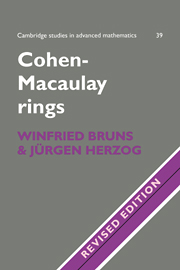In this chapter we introduce the class of Cohen–Macaulay rings and two subclasses, the regular rings and the complete intersections. The definition of Cohen–Macaulay ring is sufficiently general to allow a wealth of examples in algebraic geometry, invariant theory, and combinatorics. On the other hand it is sufficiently strict to admit a rich theory: in the words of Hochster, ‘life is really worth living’ in a Cohen–Macaulay ring ([183], p. 887). The notion of Cohen–Macaulay ring is a workhorse of commutative algebra.
Regular local rings are abstract versions of polynomial or power series rings over a field. The fascination of their theory stems from a unique interplay of homological algebra and arithmetic. Complete intersections arise as residue class rings of regular rings modulo regular sequences, and, in a sense, are the best singular rings. Their exploration is dominated by methods related to the Koszul complex.
Cohen–Macaulay rings and modules
Let R be a Noetherian local ring, and M a finite module. If the ‘algebraic’ invariant depth M equals the ‘geometric’ invariant dim M, then M is called a Cohen–Macaulay module:
Definition 2.1.1 Let R be a Noetherian local ring. A finite R-module M ≠ 0 is a Cohen–Macaulay module if depth M = dim M. If R itself is a Cohen–Macaulay module, then it is called a Cohen–Macaulay ring. A maximal Cohen–Macaulay module is a Cohen–Macaulay module M such that dim M = dim R.
In general, if R is an arbitrary Noetherian ring, then M is a Cohen–Macaulay module if Mm is a Cohen–Macaulay module for all maximal ideals m ∈ Supp M.
